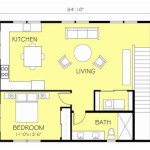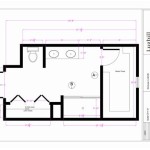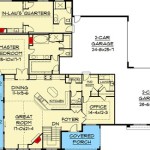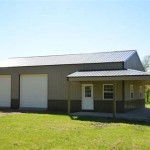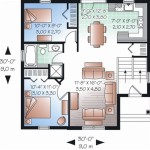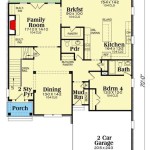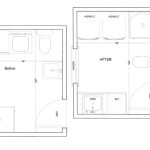2 Bedroom Beach House Floor Plans: Optimizing Coastal Living
The allure of coastal living is undeniable, with the promise of ocean breezes, stunning views, and a relaxed lifestyle. For those seeking a seaside retreat, a 2-bedroom beach house offers a balance of comfortable space and manageability, making it an ideal choice for small families, couples, or individuals. The key to maximizing the potential of a 2-bedroom beach house lies in a well-designed floor plan. This article explores the important considerations and common layouts associated with 2-bedroom beach house designs, focusing on functionality, aesthetics, and adaptability to the coastal environment.
Beach house floor plans differ significantly from those of typical suburban homes due to the unique demands of a coastal setting. These demands include maximizing natural light and ventilation, providing protection from the elements (wind, salt spray, potential flooding), and often incorporating outdoor living spaces that seamlessly blend with the interior. Efficient space utilization is also paramount, as beach houses are often located on smaller lots or within established coastal communities.
Key Considerations in 2-Bedroom Beach House Floor Plans
Several crucial elements should be carefully considered when designing or selecting a 2-bedroom beach house floor plan. These factors influence the overall comfort, functionality, and long-term value of the property.
Orientation and Views: Maximizing views is arguably the most important aspect of a beach house. The floor plan should be designed to capture the best possible vistas of the ocean, beach, or surrounding landscape. Large windows, sliding glass doors, and strategically placed balconies or decks are essential for achieving this. The orientation of the house on the lot is also critical. Ideally, the main living areas (living room, dining room, and master bedroom) should face the ocean or preferred view. Furthermore, consider the path of the sun throughout the day to minimize unwanted glare and heat gain, especially on west-facing elevations.
Open-Concept Living: Open floor plans are particularly well-suited for beach houses. By combining the living room, dining room, and kitchen into a single, flowing space, the design creates a sense of spaciousness and facilitates social interaction. This layout also allows for unobstructed views from multiple points within the house. The open-concept design also allows for natural light to permeate throughout the living spaces. The kitchen often includes a breakfast bar or island that can serve as a casual dining area, maximizing counter space, and making it easier to prepare and serve meals. Zoning the open space appropriately with strategic furniture placement will define each area without the need for walls.
Indoor-Outdoor Connection: A seamless transition between indoor and outdoor living spaces is a hallmark of beach house design. Large sliding glass doors or French doors should connect the living area to a deck, patio, or balcony. This creates an extended living space that can be used for dining, lounging, or entertaining. The outdoor space should be carefully designed to complement the interior, with comfortable seating, shade structures, and potentially an outdoor kitchen or shower. Consider the prevailing winds and orientation of the sun when designing the outdoor space to ensure it is comfortable and usable throughout the year.
Materials and Finishes: The choice of materials and finishes is critical for durability, aesthetics, and ease of maintenance in a coastal environment. Select materials that are resistant to moisture, salt air, and UV radiation. Common choices include durable hardwoods, engineered flooring, tile, and composite decking. Light, neutral colors are often preferred for walls and ceilings to create a bright and airy feel. Consider incorporating natural elements, such as wood accents or stone features, to enhance the connection to the surrounding environment.
Storage Solutions: Efficient storage is essential in a 2-bedroom beach house, as space is often limited. Incorporate built-in storage solutions, such as shelving, cabinets, and drawers, wherever possible. Maximize vertical space by utilizing tall cabinets and shelving units. Consider adding storage in unexpected places, such as under stairs or in window seats. Outdoor storage for beach gear, such as surfboards, kayaks, and beach chairs, is also important.
Privacy and Sound Insulation: While open-concept living is desirable, it is also important to consider privacy and sound insulation, especially in the bedrooms. Position the bedrooms away from the main living area to minimize noise. Use sound-dampening materials, such as insulated walls and double-paned windows, to reduce noise transmission. Consider adding curtains or blinds to the windows for added privacy.
Common 2-Bedroom Beach House Floor Plan Layouts
Several common floor plan layouts are well-suited for 2-bedroom beach houses, each with its own advantages and disadvantages. The best layout will depend on the specific site conditions, desired aesthetic, and individual needs of the occupants.
Linear Layout: In a linear layout, the rooms are arranged in a straight line, often parallel to the shoreline. This layout is well-suited for narrow lots with limited frontage. The main living areas are typically located at one end of the house to maximize views, with the bedrooms located at the other end. This layout is simple and efficient, but it can lack privacy if the bedrooms are located close to the living area. Linear layouts often work well in a single-story design, but the design can be adapted to a multi-story design with the entry and living spaces on the lower level and bedrooms on the upper level.
L-Shaped Layout: An L-shaped layout creates a sheltered outdoor space, such as a patio or courtyard, that is protected from the wind and sun. The living areas are typically located in one leg of the "L," while the bedrooms are located in the other leg. This layout offers good separation between living and sleeping areas and can provide excellent views from multiple rooms. The L shape also provides the opportunity to create a more private outdoor space, which is advantageous in locations with heavy foot traffic or neighbors.
Stacked Layout: In a stacked layout, the living areas are located on the ground floor, while the bedrooms are located on the upper floor. This layout is ideal for maximizing views and privacy. The ground floor can be designed with large windows and sliding glass doors to create a seamless connection to the outdoor space. The upper floor is typically more private and quiet, as it is removed from street noise and activity. This layout is particularly well suited for sloped lots, where the ground floor can be partially buried into the hillside. This can provide additional insulation and protection from the elements.
Courtyard Layout: A courtyard layout centers around a central outdoor space, creating a private and secluded oasis. The living areas and bedrooms are arranged around the courtyard, which can be used for dining, lounging, or gardening. This layout provides excellent privacy and can be very energy-efficient, as the courtyard can help to buffer the house from extreme temperatures. Courtyard layouts often require a larger lot size to be effective. The design lends itself to a relaxed, tropical feel.
Adapting to the Coastal Environment
Beyond the basic layout, several design considerations are specific to the coastal environment. These include wind resistance, flood protection, and energy efficiency.
Wind Resistance: Coastal areas are often subject to high winds, so it is important to design the house to withstand these forces. This includes using hurricane-resistant windows and doors, strengthening the roof structure, and properly anchoring the house to the foundation. Consult with a structural engineer to ensure that the house meets local building codes for wind resistance.
Flood Protection: If the house is located in a flood zone, it is essential to elevate the living areas above the base flood elevation (BFE). This can be achieved by building the house on stilts or by raising the foundation. Use flood-resistant materials for the lower levels of the house, such as concrete or masonry. Install flood vents to allow water to flow in and out of the house during a flood, which can help to prevent structural damage.
Energy Efficiency: Beach houses can be prone to heat gain in the summer and heat loss in the winter. Implement energy-efficient design features, such as proper insulation, energy-efficient windows and doors, and a high-efficiency HVAC system. Use light-colored roofing materials to reflect sunlight and reduce heat gain. Consider incorporating passive solar design principles, such as orienting the house to maximize solar gain in the winter and minimize solar gain in the summer.
Durable Materials: Selecting durable materials that can withstand the harsh coastal environment is an important factor. Salt air accelerates corrosion, and UV rays can damage and degrade many materials. Composite decking, fiber cement siding, and stainless steel hardware are examples of items that are resistant to these conditions.
Exterior Design and Aesthetics: The exterior design of a beach house should reflect its coastal setting. Common architectural styles include Cape Cod, Shingle Style, and Contemporary. Use natural materials, such as wood shingles, clapboard siding, and stone accents. Incorporate nautical details, such as porthole windows, ship lap paneling, and rope railings. Choose colors that complement the surrounding landscape, such as blues, greens, and whites.
In conclusion, designing a 2-bedroom beach house floor plan requires careful consideration of various factors, including orientation, views, open-concept living, indoor-outdoor connection, and adaptability to the coastal environment. By carefully planning the layout and incorporating appropriate design features, it is possible to create a comfortable, functional, and aesthetically pleasing coastal retreat that maximizes the enjoyment of seaside living.

Plan 96705 Coastal Style With 2 Bed Bath

Small Home 2 Bedroom House Plans 117 8rh Beach Haven Nfloorplans Cottage Floor

Atlantic Beach Coastal House Plans From Home

Small And Tiny Coastal House Plans 2 Bedroom Beach Elevated Sloping Lot

Stilt House Plan With Decks And Charm 3928

Beach Style House Plan 2 Beds 1 Baths 869 Sq Ft 536 Houseplans Com

Orchid Bay Coastal House Plans From Home

Beautiful Beach House Plans Blog Eplans Com

Plan 86088bw 1925 Square Foot 2 Bed Elevated Coastal House On Pilings

Coastal Plan 1 000 Square Feet 2 Bedrooms Bathrooms Floor 028 00174 America S Best House Plans

